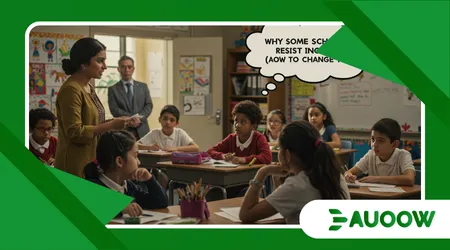Why Some Schools Resist Inclusion (and How to Change That)

Why some schools resist inclusion is a question that sparks debate in education circles, revealing deep-rooted challenges in fostering equitable classrooms.
Inclusion, the practice of educating students with disabilities alongside their peers in general education settings, is a cornerstone of modern educational policy, mandated by laws like the U.S.’s Individuals with Disabilities Education Act (IDEA).
Yet, despite decades of advocacy and evidence supporting its benefits, resistance persists in many schools.
This article dives into the reasons behind this reluctance, unpacking systemic, cultural, and practical barriers while offering actionable solutions to drive change.
Drawing from real-world examples, current research, and innovative strategies, we’ll explore how schools can embrace inclusion to create vibrant, equitable learning environments.
Why do some institutions cling to outdated models when the path to inclusion is clear? Let’s uncover the obstacles and chart a path forward.
The Roots of Resistance: Systemic Barriers
Resistance to inclusion often stems from entrenched systemic issues that prioritize tradition over progress.
Many schools operate within rigid frameworks, where budgets, staffing, and curricula are designed for uniformity, not diversity.
Why some schools resist inclusion lies in the fear of disrupting established systems. Limited funding for special education resources, like trained aides or adaptive technologies, creates a bottleneck.
Schools may lack the infrastructure to support diverse learners, leaving educators feeling unprepared.
The financial strain is real. According to a 2021 study by the National Center for Education Statistics, 65% of students with disabilities in the U.S. were educated in inclusive settings, yet schools reported insufficient funding to meet their needs.
This gap forces administrators to prioritize cost-saving over student-centered solutions. Without adequate resources, inclusion feels like an unfunded mandate, pushing schools to maintain separate special education programs.
Bureaucratic inertia compounds the issue. Some districts cling to legacy practices, like self-contained classrooms, because they’re familiar.
++ How to Design Homework for Students with Executive Function Challenges
Shifting to inclusive models requires bold leadership willing to challenge the status quo, a step many hesitate to take due to competing priorities.
Moreover, policy misalignment can hinder progress. Federal mandates like IDEA require inclusion, but local implementation varies widely.
Schools in underfunded districts struggle to comply, perpetuating resistance. Systemic change demands flexible funding and clear guidelines to prioritize inclusion.

Cultural Resistance: Mindsets and Misconceptions
Beyond structural hurdles, cultural attitudes within schools can block inclusion. Why some schools resist inclusion often boils down to misconceptions about students with disabilities.
Some educators and parents believe inclusion compromises academic rigor or burdens general education teachers. These myths persist despite evidence showing inclusive classrooms benefit all students, fostering empathy and collaboration.
Take a small rural school where teachers, untrained in inclusive practices, fear they’ll fail students with complex needs. This fear breeds resistance, rooted not in malice but in uncertainty.
Without training, educators may view inclusion as an added burden rather than an opportunity for growth.
Parental resistance also plays a role. Some families worry their child’s needs whether academic or social will be overlooked in inclusive settings.
Also read: How Assistive Tech Is Leveling the Playing Field in Education
Addressing these concerns requires transparent communication, showing how inclusion benefits everyone, not just students with disabilities.
Cultural shifts demand education. Workshops that debunk myths, like the idea that inclusion lowers standards, can change mindsets.
When teachers and parents see inclusion’s value, resistance fades, replaced by a shared commitment to equity.
Practical Challenges: Implementation Gaps
Even when schools support inclusion philosophically, practical barriers can derail efforts. Why some schools resist inclusion often ties to logistical challenges, like insufficient training or time.
Teachers may lack the skills to differentiate instruction for diverse learners, leading to frustration. A middle school in Chicago, for example, struggled when teachers received only one day of professional development annually.
Time constraints exacerbate the issue. Crafting individualized education plans (IEPs) while managing a full classroom is daunting.
Teachers may feel inclusion is untenable, even if they believe in its principles, without dedicated support.
Resource allocation is another hurdle. Schools may have assistive technologies but lack staff trained to use them effectively.
Read more: Why Inclusion Fails Without Cultural Sensitivity in the Classroom
This gap between intent and execution stalls progress, leaving inclusion as an ideal rather than a reality.
Collaboration is key to closing these gaps. Co-teaching models, where general and special education teachers work together, can ease the burden. Schools must prioritize practical support to make inclusion sustainable.
The Cost of Resistance: Missed Opportunities
When schools resist inclusion, they miss transformative opportunities. Why some schools resist inclusion matters because it deprives students of richer learning experiences.
Inclusive classrooms foster social skills and empathy, as seen in a Seattle elementary school where peer mentoring boosted academic outcomes for students with autism.
The cost extends beyond students. Teachers lose chances to develop adaptive teaching skills, and schools miss out on building diverse, vibrant communities.
Resistance perpetuates inequity, undermining education’s promise as a universal right.
Data supports this: a 2019 study by the National Center for Learning Disabilities found inclusive settings increased graduation rates for students with disabilities by 14%. Denying inclusion limits potential, reinforcing cycles of exclusion.
Moreover, resistance isolates schools from broader societal shifts toward diversity. Inclusive education prepares students for a world that values collaboration across differences, a skill increasingly vital in 2025’s globalized workforce.
Strategies to Overcome Resistance
Shifting from resistance to embrace requires intentional strategies. Why some schools resist inclusion can be addressed through targeted interventions.
First, invest in teacher training. Programs like the University of Illinois’ Diversity & Equity in Education equip educators with tools to manage diverse classrooms effectively.
Second, foster community buy-in. Schools can host workshops to educate parents on inclusion’s benefits, using real success stories to build trust.
A California district saw resistance drop after parent-led forums showcased student progress in inclusive settings.
Third, leverage technology. Tools like text-to-speech software or interactive platforms can bridge gaps, making inclusion feasible. Schools must prioritize accessibility to ensure no student is left behind.
Finally, pilot programs can ease transitions. Starting with small-scale inclusion initiatives allows schools to test strategies, gather data, and build confidence before scaling up.
Policy and Leadership: Driving Change
Leadership is pivotal in dismantling resistance. Why some schools resist inclusion often reflects a lack of visionary leadership.
Principals and district leaders must champion inclusive policies, reallocating budgets to prioritize training and resources.
A New York high school transformed its culture by mandating co-teaching models, pairing general and special education teachers.
Policy changes at the district level can shift the tide. Advocating for flexible funding models ensures schools can afford adaptive tools and staff. Leaders must model inclusivity, setting a tone of equity from the top.
Engaging stakeholders teachers, parents, and students in policy decisions builds trust.
When schools involve communities in shaping inclusion strategies, resistance wanes, replaced by collective commitment.
Data-driven advocacy strengthens the case. Leaders can use metrics, like the 14% graduation rate increase, to justify investments in inclusion, aligning policies with measurable outcomes.

Building a Culture of Inclusion
Creating an inclusive culture requires more than policy it demands heart. Why some schools resist inclusion often stems from a lack of shared vision.
Schools can start by celebrating diversity through events like cultural fairs or disability awareness weeks, fostering empathy among students.
Teachers play a crucial role. By modeling inclusive language and practices, they set the tone. A Texas elementary school saw bullying drop after teachers integrated inclusive literature into lessons, normalizing diversity.
Students themselves can drive change. Peer mentorship programs, like one in a Florida middle school, empower students to support classmates with disabilities, creating a ripple effect of acceptance.
Community involvement amplifies impact. Schools can partner with local organizations to host inclusion-focused events, reinforcing the message that diversity strengthens everyone.
| Barrier Type | Example | Solution |
|---|---|---|
| Systemic | Limited funding | Flexible budgets, grants |
| Cultural | Misconceptions | Teacher training, workshops |
| Practical | Lack of training | Co-teaching, tech tools |
The Role of Advocacy and Awareness
Advocacy is a powerful tool to combat resistance. Why some schools resist inclusion can be countered by raising awareness through campaigns and storytelling.
Organizations like the Maryland Coalition for Inclusive Education amplify voices of students and families, showing inclusion’s real-world impact.
Media plays a role, too. Blogs, videos, and social media can highlight success stories, like a Georgia school where inclusion boosted academic and social outcomes. Sharing these narratives shifts perceptions, making inclusion a shared goal.
Grassroots efforts matter. Parent advocacy groups can push for policy changes, ensuring schools prioritize inclusion. When communities rally, resistance becomes harder to sustain.
Technology enhances advocacy. Schools can use social media to share student success stories, building momentum for inclusion and inspiring others to act.
A Path Forward: The Power of Collective Action
To overcome resistance, schools must unite stakeholders in a shared mission. Why some schools resist inclusion is a complex question, but the answer lies in collaboration.
Teachers, parents, and leaders must work together, leveraging training, technology, and advocacy to build inclusive systems.
Imagine inclusion as a bridge: each stakeholder lays a plank teachers with training, parents with trust, leaders with resources.
Together, they create a sturdy path for every student to cross. Isn’t it time we built that bridge for all learners?
Inclusion isn’t just a policy it’s a promise. By addressing systemic, cultural, and practical barriers, schools can transform resistance into opportunity.
The journey starts with one step: committing to change. Let’s make 2025 the year inclusion becomes the norm, not the exception.
FAQ: Common Questions About Inclusion Resistance
What is inclusion in education?
Inclusion means educating students with disabilities alongside peers in general classrooms, ensuring equal access and support.
Why do teachers resist inclusion?
Lack of training, time, or resources often fuels fear of failing diverse learners, though professional development can address this.
How can parents support inclusion?
Parents can advocate for training, attend workshops, and share success stories to build community trust in inclusive practices.
What are the benefits of inclusion?
Inclusive classrooms boost empathy, social skills, and academic outcomes, with a 14% higher graduation rate for students with disabilities.
